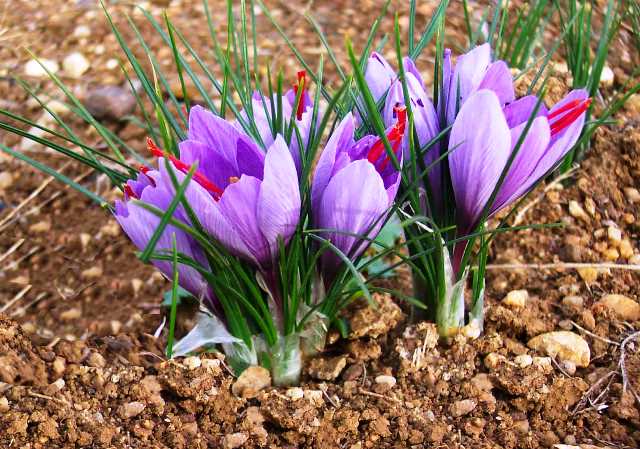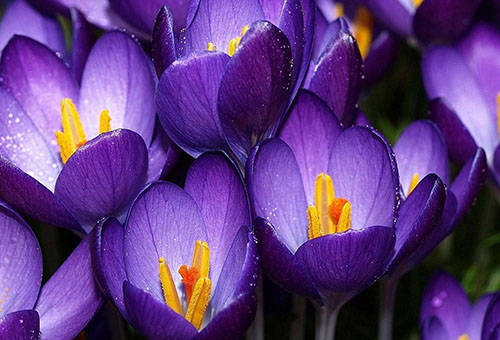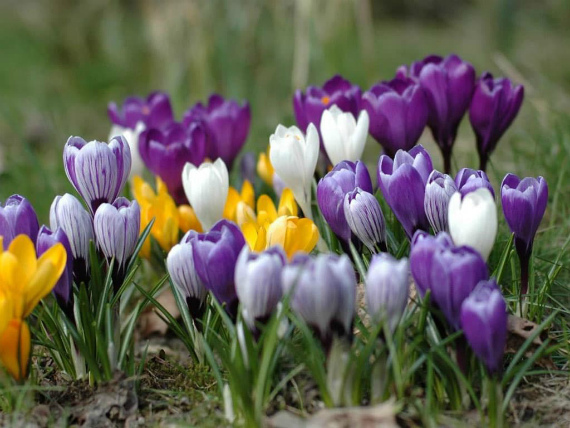Crocus care
Crocuses are flowers that reproduce on their own. They are unpretentious, but require care. Primroses do not tolerate excessively wet soil, drafts and thick shade. When caring for crocuses, consider the following rules:
- Use only healthy, undamaged tubers.
- To avoid disease and pest reproduction, periodically change the planting site.
- During severe frosts, mulch the flowers using dry leaves, straw, peat or needles.
- In order not to damage the tender sprouts in the spring, remove the mulch before the beginning of the growing season.
- Before watering the plants, be sure to loosen the soil. This will provide moisture and air access to the root system.
- Watch out for careful watering after sprouting and during flowering.
- Cut off the inflorescences and dry leaves when the crocuses have faded.
If you applied fertilizer to the soil before planting crocuses for the first time, then this top dressing is sufficient during the year. Reintroduce the fertilizing containing potassium and phosphorus into the soil already in the second year of the primroses' life.
Fertilize the soil in three steps. First, fertilize when the first shoots appear, then repeat the procedure while tying the buds. Feed the crocuses one last time after flowering. Prepare the first feeding in the following proportion: 2 parts of potassium and 1 part of phosphorus. In the future, mix fertilizers in equal parts.
If you plan to transplant flowers to another place, carefully dig up the tubers, dry them in a ventilated place. After that, put them in a box, wrapping each onion in a newspaper, put it in a cold, dark place. Keep the planting material until September – October, after which plant the flowers in open ground.
As soon as the snow begins to melt, the crocuses will again delight you with exuberant flowering. It lasts only 7-10 days, but with their beauty and tenderness, crocuses are able to create a mood and evoke positive emotions.
How to plant crocuses
We have determined when to plant crocuses outdoors in the fall. Planting any plant begins with choosing a place for it. For crocus, clearings open to the sun's rays on the hills are chosen. It is permissible to plant a primrose under trees, whose crowns bloom late and do not shade flowers in April - early May.
Crocus does not tolerate wet soil and stagnant melt water. Flower bulbs can rot.
The soil for the plant is prepared fertile, loose, well-drained.
Green crops, grains and vegetables (cucumbers, zucchini, cabbage) are good predecessors of crocus. Bulbous plants are not planted after other flowers, potatoes, tomatoes.
Crocuses are grown in one place for up to 5 years.
The preparation of the crocus and other snowdrops beds begins 2 weeks before planting the bulbs. The soil is dug onto the bayonet of a shovel, removing the roots of the weeds. On a plot of 1 sq. meter of area, contribute:
- sand from 5 to 12 kg, depending on the type of soil (more sand is required on loams);
- humus (rotted manure or compost) 5 kg;
- wood ash from burning grass or wood 200 - 300 g;
- superphosphate 40 g;
- potassium salt 30 g.
If planting crocus is planned on clay soil, in addition to sand, fine gravel or vermiculite is added.
The acidity of the soil should be 6-6.5 units. Acidic soils are limed by adding chalk or lime, in the amount of 250-400 g per 1 sq. meter.
After digging and adding additives to the soil, the area for the flower garden is leveled and left for several days so that the soil settles and the fertilizers dissolve. If the fall is dry, the soil can be additionally shed with water.
Preparation of planting material
A healthy crocus bulb should be:
- dense and juicy, heavy to the touch;
- the scales on the onion are dry;
- bulb size - at least 3 cm in diameter;
- there are no traces of rotting or mechanical damage on the tuber.
Bulbs with awakened sprouts are not suitable for autumn planting, they will not survive the winter. Such planting material is planted in pots and removed to the cellar. Flowers can be used for winter forcing.
Immediately before planting, crocuses must be pickled in a fungicide solution in order to destroy pathogens of fungal diseases. Use drugs for this:
- Maxim, Fundazol, Skor, - diluting them according to the instructions.
- You can apply a bright pink solution of potassium permanganate. Etching time is about half an hour.
Planting scheme for primrose
Crocuses are small-bulbous flowers that look beautiful when planted in groups. The bulbs of the plant are placed in clearings of arbitrary shape so that the distance between the bulbs remains equal to 4-5 cm.
For the convenience of the subsequent digging of crocus planting material and collecting its babies, gardeners practice planting bulbs in special baskets. A plastic low container with drainage holes is dug into the ground, later it can be easily removed. The whole baby will stay inside, you don't have to look for her all over the flower garden.
There is a secret on how to prolong the short flowering of crocus. Its bulbs of the same size are placed to a depth with a difference of 1 - 3 cm. As a result of this planting, a deeper-planted crocus will bloom a few days later.
A layer of dry sand with a layer of 2-3 cm is poured onto the bottom of the dug holes. Onions are placed on it. After covering the crocuses with soil, the surface of the earth is mulched with wood chips, peat, wood chips or bark. Looks aesthetically pleasing mulch made from pine nut shells. Mulch protects crocus from freezing and prevents weeds from growing.
Should crocuses be watered when planting in the fall?
If the weather is dry after planting the flower, then watering is necessary for the plant. Enough 1 - 2 plentiful watering, with soil moistening to a depth of 15 cm.
A flower bed of tulips, hyacinths, crocuses - planting scheme in autumn
In drawing up a flower garden, joint planting of different types of plants is practiced with similar requirements for agricultural technology and soil structure. Early bulbous flowers are placed in common flower beds.
A colorful flower bed of hyacinths, tulips and crocuses is formed according to the following principles:
- tall flowers (tulips) are in the background, crocuses, as the smallest ones, in the front row;
- the color combination is selected by playing in contrast (blue hyacinth + yellow crocus + scarlet tulip);
- varieties are selected according to the flowering period so that the flowering lasts as long as possible.
When planting plants in a flower bed, first of all, tulips and hyacinths are placed in the ground. Their bulbs require a planting depth of 15-16 cm. The distance between flowers is maintained at 10-15 cm. Crocuses, as the smallest plants, are planted shallowly (8-10 cm).
Crocus soil
The best soils for growing crocuses are light loams. During the summer dormancy, the development and laying of flower buds is very well influenced by the dryness of the soil, therefore, when preparing the site for planting, at least a small drainage from coarse river sand or fine gravel is usually arranged. Nutrient compost, rotted manure or peat (with the addition of lime) are added to poor soils before planting.
It is useful to give mineral fertilizers (phosphate-potassium) to spring crocuses in early spring, on melted snow. Organic - late fall. Autumn species, on the contrary, receive mineral fertilizing in the fall, after flowering, and organic - in early spring.

How to choose the optimal crocus soil
Crocuses require a well-moistened soil during the growing season. Therefore, after a winter with little snow and a dry spring, it is useful to water the plantings: once - at the beginning of the appearance of buds, then - during the period of leaf formation.Left without watering, the plants, of course, will not die, but they will bloom faster, and subsequently receive less nutrients due to the weak development of the leaves. As a rule, autumn crocuses do not need watering during the flowering period.
Agricultural rules
Crocus care in the open field will not take much time. They practically do not need watering. It will be necessary to moisten the soil in the beds only when there was no snow in winter and rain in spring. The amount of water received by the bulb affects only the height of the plants; in general, they tolerate drought well. In the summer, watering crocuses is even harmful; in the resting phase, dry soil is preferable for them.
The essential elements of flower care include:
- top dressing;
- regular loosening of the soil;
- weed removal.
During the period of active growth, the plants must be fed. Fresh organic fertilizers are contraindicated for them, their introduction can provoke various diseases. They are fed only with mineral compounds. Of these, it is better to choose those that contain a lot of phosphorus and potassium and little nitrogen. Its excess in the soil stimulates active growth on the flowers of excess leaves, which can cause fungal diseases to strike them. It is especially dangerous in wet weather. It is permissible to use peat or manure for soil enrichment, but only completely rotted.
It is recommended to carry out two dressings. The first is carried out in early spring, while the snow has not yet melted, scattering complex fertilizer over it. The second time crocuses are fed when 14-21 days have passed since the beginning of their flowering, using preparations with a minimum nitrogen content. During this period, plants especially need potassium. It helps their bulbs to develop into high quality and healthy planting material. After the foliage on the crocuses turns yellow, they are left alone until the end of the season.
Crocuses are wonderful plants that are one of the first to fill the garden with bright colors and give a charge of positive emotions after long dull months filled with snow and cold. The very embodiment of spring, they look spectacular on the alpine slides, giving them a unique charm. It will be impossible to look away from the magnificent living carpet if you plant them in dense linen on a flower bed or lawn. And growing them in pots at home will allow you to admire the magnificent flowering already in winter.
In addition to high decorative qualities, crocuses are surprisingly unpretentious, even an amateur who has no experience in gardening can cope with their planting and reproduction. They only need minimal care in the form of top dressing, loosening the soil and weeding. Plant crocuses on your property and you won't regret your decision for a minute!
- decrease in the body's immune defenses
- drowsiness
- frequent fatigue
- depression
- headaches, as well as various pains and spasms in the internal organs
If you feel frequent ailments, you just need to cleanse your body. How to do it
Mostly bloom in early spring,
therefore, their bulbs need to be planted in the ground before winter, about
September-October. Therefore, to obtain blooming crocuses, the following
in the spring, planting material must be purchased in the summer.
However, there are crocus varieties that bloom in autumn (from August to
September). In this case, planting should be carried out in the summer, from July to
August. Considering the special whimsicality of autumn crocuses and careful care
behind plantings, such varieties have not received mass distribution.
Some growers use the features of agricultural cultivation techniques.
crocuses to get flowers in pots by a certain date (for example, to
March 8). This is easy to do even at home.
Characteristics and description of saffron
As a rule, almost all varieties bloom with the onset of spring, but you can find varieties that bloom in the fall, the so-called autumn-flowering crocuses.
white crocuses
A feature of unusual primroses is the absence of aerial shoots. In addition, they are characterized by large, upward-looking inflorescences. During their bloom, the blossoming flowers can be compared to glasses or funnels, consisting of six petals growing from a corm. After the buds have fully blossomed, they are cupped or star-shaped.
On personal plots, you can grow not only the original species, but also beautiful and large hybrids bred by professionals. The timing of planting crocuses in the fall in the Moscow region, for example, is similar to growing in other cities of the country.
The stigma of saffron is dried and used as a natural yellow dye or spice in many countries since ancient times. Not all varieties are suitable, but only crocus sowing, Altavsky (Crocus alatavicus) or fine saffron, from the “nominal” variety Palasi, also known as Crocus pallasii. More information can be found here.
Is it possible to transplant daffodils, crocuses, tulips in the summer? will they not perish?
Alexander
You have already been told about digging out the faded bulbous ones - everything is correct if they have gone underground, that is, the foliage has withered. Now I will tell you how to transplant flowering or still with dry foliage. It is not necessary to dig it out with a clod of earth. Before digging out, prepare the following: a stack of old newspapers or an appropriately sized paper of any kind, a bucket of water, a cardboard box large enough to hold tulips or whatever you have full length. Your actions: moisten a newspaper in water, spread it, dig out a tulip, lay it diagonally on the newspaper, wrap it loosely on top, the bulb itself can be tighter, place the “doll” in a cardboard box. When the box is full, close it, seal it with tape. In this state, in a cool place, the plants will be ready for transplanting for about a week. When planting, remove the flower, leave 2-3 leaves for breathing, water the flowers abundantly and shade them. Will take root. They will bloom next year.
Elena Orlova
if still blooming, then with a lump of earth it is possible, and since the leaves will fade and the leaves will wither, dig it up and plant it where necessary in September-October
Irina Vladimirovna
The first method is digging, after flowering; the second - digging without destroying the earthen coma with an integral root system + planting in a prepared place.
Kitty
And you can and should. Therefore, read about bulb farming in winter (note that small bulbous crocuses are one approach to them), and you will know WHY and WHY Ephemeroids are planted in autumn, they winter in the ground, bloom in early spring and dug out at a certain time.
Varieties of flower culture
Plants are conventionally divided into 15 groups, differing in color of inflorescences and height of bushes. The first includes hybrids that bloom in autumn. The rest are spring-flowering varieties, most of which were bred by Dutch scientists.

Another separate group consists of hybrid specimens obtained as a result of crossing the golden and two-flowered crocus:
- Spring crocus. Reaches a height of 17 cm. The bulb is flattened, covered with mesh scales. Straight narrow-linear leaves with a white-silvery longitudinal stripe develop from the root. The flowers are white or purple, with a long funnel-shaped tube.
- Two-flowered crocus. Differs in a variety of shapes and shades - from pure white to brownish-purple.
- Crocus Tomasini. The perianths are painted in lilac-pink tones, there are specimens with a white edging along the edge. The opened inflorescences have the shape of a star with a white throat and a tube of the same shade. One tuber produces 1-3 flowers up to 60 mm long. Flowering begins in April, lasts 18-21 days.
- Crocus golden. Reaches 20 cm in height, has corms of a flattened spherical shape. Leaves are golden, straight, with shiny perianths.Outside, the petals of some hybrids are decorated with brownish markings or stripes. The stem is red, the anthers are orange.

Hybrids that bloom in autumn are represented by several varieties, including:
- Crocus Beautiful. The flowers are purple-lilac with burgundy veins, up to 70 mm in diameter. The length of the leaves is up to 30 cm.
- Crocus Pretty. An incredibly attractive plant with light purple flowers adorned with dark paths. Their height reaches 7-10 cm, in diameter - about 60-80 mm. Blooms in September-October, 5-10 flowers appear on each bush.
- Crocus Banatsky. It has gray-silver straight leaves about 15 cm long, the height of the bush is up to 14 cm, inflorescences of a light lilac shade with yellowish anthers.
Interesting! Growing phlox perennial: planting and care, varieties
Dried crocus stigmas are used to make the popular condiment, saffron.


